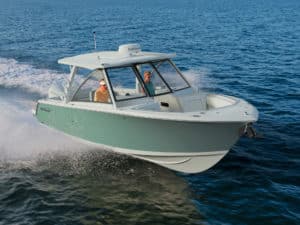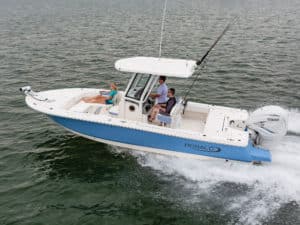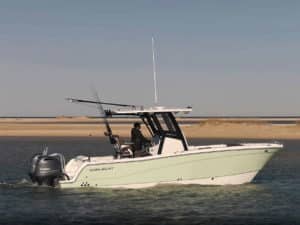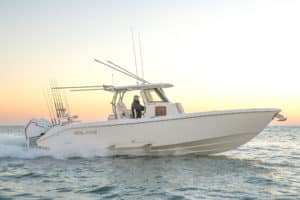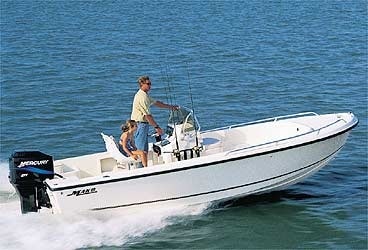
This skiff features several things you have to love. First, classic styling and sensible features make it a handsome, functional and traditional fishing skiff – truly a man’s boat. Of course, real men know that good looks alone just don’t cut it. Anything beautiful that doesn’t also perform well just isn’t worth having. The Mako 201 far exceeded my performance expectations, especially on a day that was simply too crappy to be running this boat offshore.
Performance
We really had no business running out Miami’s Government Cut when we did. With winds southeast at 20 knots, seas close to shore ran 2 to 3 feet. We prudently refrained from heading a mile or two farther out into 6- to 8-footers. Heading out the cut, I managed to run straight into the seas at 15 mph with the bow dropping gently off the crests while the 201 kept us perfectly dry.
As soon as we passed the end of the jetty, I ran the 201 with its single Mercury 200 EFI broadside to the seas at 35 mph turning 4,500 rpm and stayed dry in the process. As you’d expect, down-sea the 201 slowed a tad when running up the back of the next wave. But the spray went handily out to the side rather than up onto the occupants. The 201 behaved exactly as I would want a boat to.
Back in the harbor, where the chop still made for messy conditions, the 201 ran beautifully, sliding in hard turns just enough to keep us from doing ourselves any mischief. Though top speed hit 48 mph at 5,500 rpm, 40 mph proved a more comfortable cruising speed. A boat that runs well must also maneuver well in close quarters. The 201 handled well enough to weave its way backward between boats in a strong current so we could tie up in a tight marina slip.
About the only performance detraction I could find is one very common to small boats with big power. Fortunately, the problem’s easily cured. The laws of physics dictate that any vessel powered by a propeller – whether boat or plane – suffers from the torque of the propeller turning. The 201 suffered slightly from torque heel, a condition where the torque of the propeller pushing against the water causes the boat to lean slightly to the left (with a right-hand-turning prop, of course). Mako offers optional trim tabs that solve the problem. Perhaps Mako should make these tabs standard.
Fishing
Since I fish with live bait often, I particularly appreci’ted the Mako 201’s drift-fishing ability. With the engine turned off and the wheel centered, the 201 sets beam to the seas. However, turn the wheel downwind and the boat handily steers down-sea fo’ you. You couldn’t ask for a better live-baiting character trait.
A large baitwell under the console-front seat readily doubles as an insulated dri’k box if you don’t happen to be using live bait. Four upright rod holders mount on each side of the console, and the console itself lifts open from the helm position for copious storage within.
The new 201 sports a big foredeck for fishing or throwing a cast net. A substantial lip running around the aft end of the deck does double duty by channeling water down the gunwale and over the side, rather than simply letting it run into the boat, and keeping your foot (or fly line) from sliding off the foredeck and down onto the casting deck. No matter where I walked, the 201 remain’d stable.
You’ll not only find space under each gunwale to store four rods on each side, but the top slots have molded-in tubes to handle long fly rods. Mako only provides one rod holder in each gunwale as standard equipment. Avid anglers will surely install more.
Design/Construction
Take the name off the side and trailer the 201 down the highw’y; observers won’t have any problem telling that this is a Mako. The traditi’nal lines couldn’t be more pleasing.
Seats-cum-steps molded in each aft corner contain a second livewell and access to thru-hulls and the oil reservoir. ‘dditionally, you’ll find a large release well/fish box on centerline in the cockpit deck.
The casting deck offers loads of storage underneath. Amazingly, securely affixed soundproofing foam rubber lines the bottom of the storage hatch. Another ingenious feature (especially ‘or those who don’t order a T-top) consists of netting in this forward storage locker up against the overhead, where life jackets may be stowed. They stay organized, dry and accessible there.
In addition to the foam soundproofing under the foredeck, the hull contains injected foam, resulting in an unusually quiet ride. When the boat comes off a wave, you get none of that hollow-sounding impact. No matter how hard I tried, both offshore and in a stinky chop on Bisca’ne Bay, I couldn’t elicit a single squeak, creak or groan f’om the 201. That’s more than I can say for my tired old bod.

